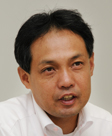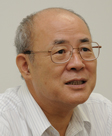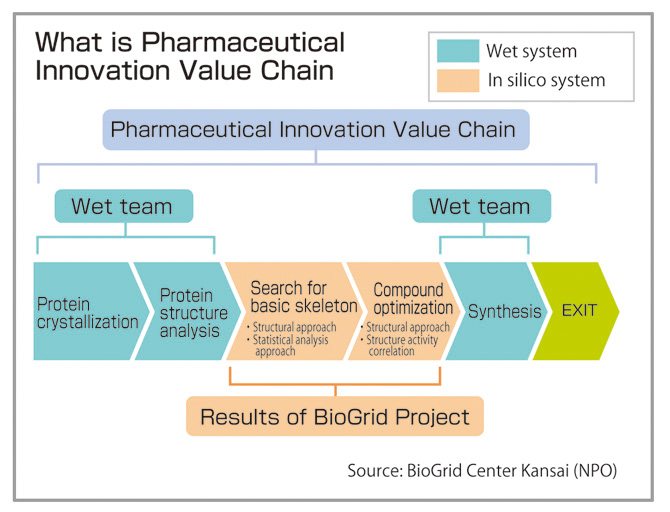
Biosupercomputing Pioneers the Future of Life Science
What should we do to promote industrial use of sophisticated computer resources and development applications?


Chief Coordinator of Foundation for Computational Science
Masahiro Fukuda (left photo)
Chief Researcher of Urban Innovation Institute and
Executive Board Member and Bureau Chief of BioGrid Center Kansai
Ryuichi Shimizu (right photo)
●Why computer simulation is not widespread in private companies?
━ You two are members of the Preparation working group on promotion of industrial use in the HPCI consortium. First, would you tell us what kind of work you are doing now? Incidentally, Mr. Fukuda was engaged in the development and operation of the Numerical Window Tunnel (NWT), the supercomputer that once achieved the world speed record at the National Aerospace Laboratory of Japan, and then has consistently worked in computational science and contributed to its development.
FUKUDA (Honorifics omitted): Now I belong to the Foundation for Computational Science which was established to motivate Japanese industry by disseminating computational science and simulation technology, and help various private companies with research and development utilizing supercomputers. Our foundation also has a supercomputer for industry, the “FOCUS Supercomputer,” which promotes advanced technology in the industry. I hope you make extensive use of it.
SHIMIZU : I’d like to speak about the BioGrid Center Kansai I am involved in. Originally, Osaka University promoted the “BioGrid Project.” It aimed at running development applications for bio and medical care in a grid computing environment. In order to get the technology and research products widely utilized in, for example, the industrial arena, we established the BioGrid Center Kansai (NPO). In 2004, we started a testbed and appealed for its use, but initially pharmaceutical companies took no ac tion. We reser ved Osaka University’s supercomputer, installed applications in it and were ready for running them, but pharmaceutical companies would not use them, saying “we cannot provide our data” or “we are not allowed to connect our network to outside.” So, we decided to get results by ourselves. We cooperated with a venture company from Osaka University which began operation and started a Development Project for Creation of an Intellectual Cluster. The year after, the National Institute for Biomedical Innovation asked us if we could do in silico drug discovery with them. Then, the “Drug Discovery Value Chain Project” (We named it “Pharmaceutical Innovation Value Chain”) which creates pipeline compounds based on computer simulation was started. It was a time when the trend toward in silico drug discovery was about to take off. That might be also helpful.
FUKUDA : Were applications available at the BioGrid Center Kansai developed by professors at Osaka University?
SHIMIZU : We use various a pplications. But we basically use a docking simulation (myPresto) developed by Professor Haruki Nakamura, from the Institute for Protein Research, Osaka University, and Mr. Yoshifumi Fukunishi, from the National Institute of Advanced Industrial Science and Technology.
FUKUDA : After starting the project, were detailed calculations done by people from the pharmaceutical companies?
SHIMIZU : We outsourced them to a company. Pharmaceutical companies did not participate in the first place. We planned the development without pharmaceutical companies.
FUKUDA : I see. This is why I asked. I often hear that although researchers develop applications, private companies cannot master them easily. They need supporters teaching them step-by-step how to use such applications. Therefore, those applications do not get used by private companies.
SHIMIZU : There are certain levels of acceptance in the pharmaceutical industry. About 10 of Japan’s largest companies have personnel who have solid knowledge of computational science and enough ability to use supercomputer by themselves. As they want to know the details, they ask for explanations on applications. After that, they only need some basic training. Among those companies, about three companies are actively using university supercomputers for computing with us.
FUKUDA : Several companies have already gotten that far, right?
SHIMIZU : Although I don’t know what level of computational resources they have, I think major companies have an in-house compound library and a system good enough to do reactive tests by themselves to find the compound. However, there are many companies which ask for teaching from the basics up. Some companies say they want to study to work on drug discovery using supercomputers like major companies in the future, and participate in our research project as observers, of course after signing confidentiality agreements.
FUKUDA : There are some companies which are determined to take a proactive approach to supercomputers among middle-class pharmaceutical companies, right?
SHIMIZU : Yes, but I doubt such a proactive approach will spread throughout the pharmaceutical industry. I get the impression that it has not yet become the mainstream, and that many companies do a bit of simulation for drug discovery when their experimental trials go nowhere.
FUKUDA : You mean that it is not yet the mainstream that the in silico team first does a simulation, which is finished up by experiment?
SHIMIZU : There seems to be a problem of time. They say they can see results faster by doing experiments than waiting for computational results for half a month. Due to such time-lag problems and other things, the synthesis team and in silico team do not collaborate well in their systems, I think. Since some have been doing what they can do with their conventional computational resources, they don’t think they can do large-scale computation and are discouraged from the very start. From the beginning, they cannot imagine doing a simulation aggressively with an unusual resource like “K computer”.
●Pharmaceutical companies are changing their understanding of simulation.
━ Is it still the same, the situation you mentioned before that they cannot take data outside the company, or they are banned from connecting to the network?
SHIMIZU : I think their a ttitude is changing little by little. There may be circumstances that they cannot afford to concentrate their personnel only on computation. It seems that there is a growing movement to allow outsourcing of routine computation as far as an interorganizational confidentiality agreement is signed.
FUKUDA : I think reliable organizations must be provided that take care of computation for important industries. For example, RIKEN takes care of computation for the pharmaceutical industry. Such a system should be prepared as national policy. By doing this, you can make clear who is responsible. Not to mention cost-effectiveness, you can gather all sorts of know-how. The FOCUS supercomputer of our foundation was introduced exactly with the concept of being used by the industrial sector. Although its level is 25TFLOPS meaning not so powerful, I am pretty sure there is enough demand after visiting many companies to talk to them. Many companies we have visited are in the field of CAE (Computer Aided Engineering). We have not yet visited so many pharmaceutical companies, but I think there is enough demand from what I hear from you.
SHIMIZU : The pharmaceutical industry is now in a transition stage. They had been defensive, but they are starting to think they should use outside resources. On the other hand, No.1 in the world, “K computer” is starting to gear up for industrial use. I feel the time is right. Only we have to present successful examples, or when a tangible achievement is made, some pharmaceutical companies may get interested and begin using supercomputers.
FUKUDA : In this regard, the result of the RIKEN grand challenge has become very crucial.
SHIMIZU : No other country has put more effort into the development of biosimulation than Japan. I can say Japan is the world leader in this field. Since the wisdom of the Japanese people has come this far, it would be a waste not to use it. What a shame. We should all publicize it.

●Sprouts do not appear without sowing seeds, although you water the ground.
━ We cannot produce new drugs easily today, but what is the expectation for computer simulation in the pharmaceutical industry as a method to find candidate compounds?
SHIMIZU : I don’t know the full details, but I think a willingness to do computer simulation is being fostered. However, they don’t have the necessary know-how and might still be hesitating. Also, top executives may mistrust us. For example, they may think, “Can drugs be developed in such a manner?” I think it is our challenge to change their attitude.
FUKUDA : There was a story when I still worked in the National Aerospace Laboratory of Japan. When we introduced a supercomputer, we told major companies in the industry that simulation must be used more in the development of aircraft. However, the middle managers at that time expressed little enthusiasm. What I did next was talk with young frontline engineers who were eager to absorb new technologies. Then, I had them use applications we had developed as much as they liked. Next, I went to see the director of the company and said, “Japanese technology won't go anywhere unless we start now”. However, he still didn't lift a finger. Then, I said, “Your young and active engineers are very enthusiastic”. Then, he got interested, saying, “I would listen to your idea if we have such young engineers,” and I was able to proceed further. That was a real experience. It is crucial to find out how to input data in the company. It is not always good to rush things and negotiate only with senior management. Sprouts do not appear without sowing seeds, although you water the ground as much as you can.
SHIMIZU : In fact, similar things are going on in pharmaceutical companies. While we are undertaking joint research with them by using applications developed at the university, they will bring in their assignments, and are going to feed them back into the computation.
FUKUDA : After getting a result, someone in a higher position only has to give the top management a kick in the butt (laugh).
━ Do you have something you would like researchers developing applications to know as regards industrial use?
FUKUDA : Applications are easy to understand when a sample calculation is ready. For example, this input results in this computation and so on. In addition, it would be good to have additional functions that can respond to various requests from companies, for example a program that can be applied to a slightly different calculation. By meeting such requests willingly, a relationship of trust would be built up fostering a willingness to work together in a team environment. Of course, it does not mean that you do everything the company suggests from A to Z.
SHIMIZU : I want them first to build tidy applications and then to prepare basic manuals, because the user interface and so on are not the area of researchers. If possible, the application should focus on versatility.
FUKUDA : It is not good that an application can be used for one group of compounds but not another.
SHIMIZU : Anyway, we aim at understanding and widespread use of supercomputer simulation, and would like to spread the word mostly among pharmaceutical companies that you can do these applications or that we have these great applications.
━ We may still have big challenges to overcome, but I feel I can look forward to the future. Thank you for coming today.
BioSupercomputing Newsletter Vol.5
- SPECIAL INTERVIEW
- The time has come for biosupercomputing to get results with the world's No. 1 supercomputer
"K computer", and take up the challenge of "prognostic biology".
Deputy Program Director of Computational Science Research Program, RIKEN Ryutaro Himeno - What should we do to promote industrial use of sophisticated computer resources and development applications?
Chief Coordinator of Foundation for Computational Science Masahiro Fukuda
Chief Researcher of Urban Innovation Institute and Executive Board Member and Bureau Chief of BioGrid Center Kansai Ryuichi Shimizu
- Report on Research
- Analysis of molecular mechanism of enzymatic reactions by QM/MM Free Energy Method
Graduate School of Science, Kyoto University Shigehiko Hayashi (Molecular Scale WG) - Computational Mechanobiology of Actin Cytoskeleton
Institute for Frontier Medical Science, Kyoto University Yasuhiro Inoue (Cell Scale WG) - Development of Blood flow Analysis Method for Simulation of Thrombus Formation
Department of Mechanical Engineering, The University of Tokyo Satoshi Ii (Organ and Body Scale WG) - Development of Data Assimilation Technology for Simulation of Living Things
The Institute of Statistical Mathematics Tomoyuki Higuchi (Data Analysis Fusion WG)
- SPECIAL INTERVIEW
- Pioneering the Future of Computational Life Science toward Understanding and Prediction of Complex Life Phenomena
Program Director of RIKEN HPCI Program for Computational Life Sciences Toshio Yanagida
Deputy- Program Director of RIKEN HPCI Program for Computational Life Sciences Akinori Kidera
Deputy- Program Director of RIKEN HPCI Program for Computational Life Sciences Yukihiro Eguchi
- Report on Research
- Simulation Applicable to Drug Design
Research Center for Advanced Science and Technology, The University of Tokyo Hideaki Fujitani (Field 1- Program 2) - An Ultra-fast Analysis System for Next-Generation DNA Sequencer Data
Graduate School of Information Science and Engineering, Tokyo Institute of Technology
Yutaka Akiyama, Takashi Ishida, Masanori Kakuta, Shuji Suzuki (Field 1- Program 4)
- Report
- BioSupercomputing Summer School 2011
Computational Science Research Program, RIKEN Yasuhiro Ishimine (Organ and Body Scale WG)
Research and Development Center for Data Assimilation, Institute of Statistical Mathematics Masaya Saito (Data Analysis Fusion WG)
Niigata University of International and Information Studies Eisuke Chikayama (Cell Scale WG)
School of Medicine, Tokai University Yohei Nanazawa (Cell Scale/Organ and Body Scale WG)
Computational Science Research Program, RIKEN Takashi Handa (Brain and Neural Systems WG)
Computational Science Research Program, RIKEN Gen Masumoto (High-performance Computing Team)
Computational Science Research Program, RIKEN Kei Moritsugu (Molecular Scale WG) - “Next-Generation Integrated Simulation of Living Matter (ISLiM)”, a web page dedicated to new applications, has opened.
Computational Science Research Program Integrated Simulation of Living Matter Group
- Event information
